technical specifications Seat Exeo 2013 Owner's manual
[x] Cancel search | Manufacturer: SEAT, Model Year: 2013, Model line: Exeo, Model: Seat Exeo 2013Pages: 319, PDF Size: 4.81 MB
Page 261 of 319
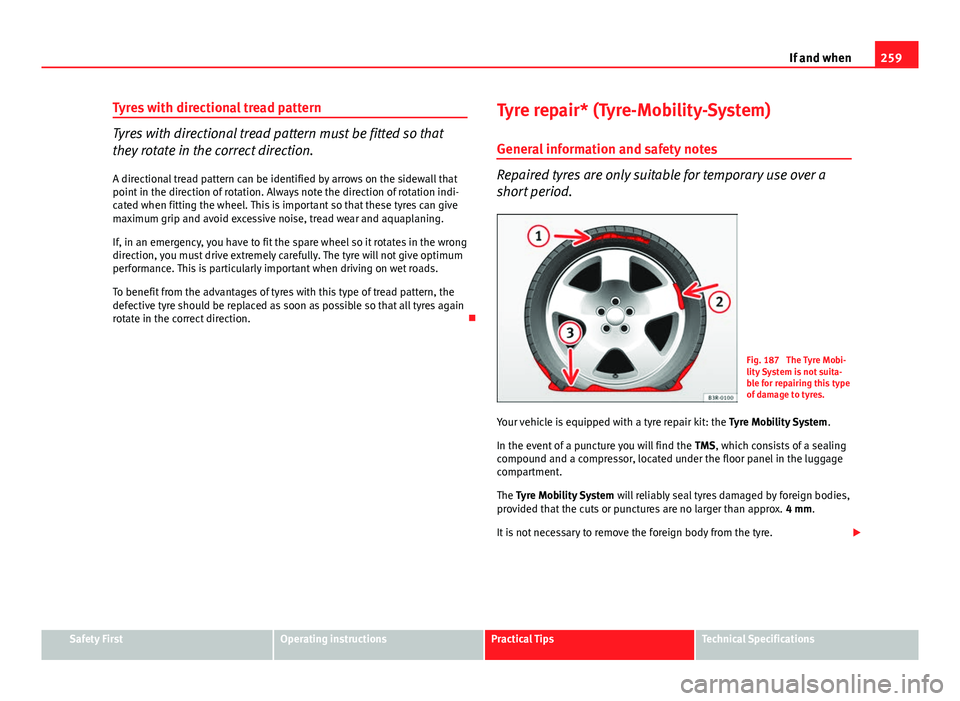
259
If and when
Tyres with directional tread pattern
Tyres with directional tread pattern must be fitted so that
they rotate in the correct direction. A directional tread pattern can be identified by arrows on the sidewall that
point in the direction of rotation. Always note the direction of rotation indi-
cated when fitting the wheel. This is important so that these tyres can give
maximum grip and avoid excessive noise, tread wear and aquaplaning.
If, in an emergency, you have to fit the spare wheel so it rotates in the wrong
direction, you must drive extremely carefully. The tyre will not give optimum
performance. This is particularly important when driving on wet roads.
To benefit from the advantages of tyres with this type of tread pattern, the
defective tyre should be replaced as soon as possible so that all tyres again
rotate in the correct direction. Tyre repair* (Tyre-Mobility-System)
General information and safety notes
Repaired tyres are only suitable for temporary use over a
short period.
Fig. 187 The Tyre Mobi-
lity System is not suita-
ble for repairing this type
of damage to tyres.
Your vehicle is equipped with a tyre repair kit: the Tyre Mobility System.
In the event of a puncture you will find the TMS, which consists of a sealing
compound and a compressor, located under the floor panel in the luggage
compartment.
The Tyre Mobility System will reliably seal tyres damaged by foreign bodies,
provided that the cuts or punctures are no larger than approx. 4 mm.
It is not necessary to remove the foreign body from the tyre.
Safety FirstOperating instructionsPractical TipsTechnical Specifications
Page 263 of 319

261
If and when
Repairing a tyre
Fig. 188 Repairing a tyre
Preparations
– If you have a flat tyre or puncture, park the vehicle as far away
from the flow of traffic as possible.
– Apply the handbrake firmly to prevent the vehicle from moving
accidentally on slopes.
– Engage first gear .
– Check whether a repair is possible using the Tyre Mobility Sys-
tem ⇒ page 259.
– Ensure that all passengers leave the vehicle and move away
from the danger area ⇒
.
– Take the tyre sealant can and the compressor out of the lug-
gage compartment. –
Stick the “max. 80 km/h” adhesive, which is included with the
tyre sealant can, onto the instrument panel where the driver will
see it.
Filling the tyre
– Shake the tyre sealant can well.
– Screw the enclosed filling hose onto the sealant can as far as it
will go. This will automatically pierce the foil sealing the can.
– Take the valve cap off the tyre valve and use the enclosed valve
insert tool to unscrew the valve insert ⇒ Fig. 188.
– Place the valve insert onto a clean surface.
– Remove the sealing plug from the filling hose and insert the
hose into the tyre valve.
– Hold the tyre sealant can upside down and fill the complete
contents of the can into the tyre.
– Then disconnect the hose and screw the valve insert firmly back
into the tyre valve.
Inflating the tyre
– Screw the compressor filling hose onto the tyre valve and plug
the connector into the cigarette lighter.
– Pump the tyre up to 2.0 to 2.5 bar and monitor the pressure
shown on the pressure gauge.
– If the tyre pressure remains lower than the value specified
above drive the vehicle approx. 10 metres forwards or back-
wards, so that the sealant can spread evenly in the tyre. If the
Safety FirstOperating instructionsPractical TipsTechnical Specifications
Page 265 of 319

263
If and when
Fuses
Introduction
Due to the constant update of vehicles, fuse assignments depending on
equipment and the use of the same fuse for various electrical components,
at the time of printing this manual it is not possible to provide an up-to-date
summary of the electrical components fuse positions. For detailed informa-
tion about the fuse positions, please consult a Technical Service.
In general, a fuse can be assigned to various electrical components. Like-
wise, an electrical component can be protected by several fuses.
Only replace fuses when the cause of the problem has been solved. If a
newly inserted fuse blows after a short time, you must have the electrical
system checked by a specialised workshop as soon as possible.
Additional information and warnings:
● Working in the engine compartment ⇒ page 227
WARNING
The high voltages in the electrical system can give serious electrical
shocks, causing burns and even death!
● Never touch the electrical wiring of the ignition system.
● Take care not to cause short circuits in the electrical system.
WARNING
Using unsuitable fuses, repairing fuses or bridging a current circuit with-
out fuses can cause a fire and serious injury.
● Never use a fuse with a higher value. Only replace fuses with a fuse of
the same amperage (same colour and markings) and size.
● Never repair a fuse.
● Never replace a fuse by a metal strip, staple or similar.
CAUTION
● To avoid damage to the vehicles electric system, before replacing a fuse
turn off the ignition, the lights and all electrical elements and remove the
keys from the ignition.
● If you replace a fuse with higher-rating fuse, you could cause damage to
another part of the electrical system.
● Protect the fuse boxes when open to avoid the entry of dust or humidity.
Dirt and humidity inside fuse boxes can cause damage to the electrical sys-
tem.
Note
● One single consumer could have more than one fuse.
● Several consumers could run over one single fuse.
Safety FirstOperating instructionsPractical TipsTechnical Specifications
Page 267 of 319
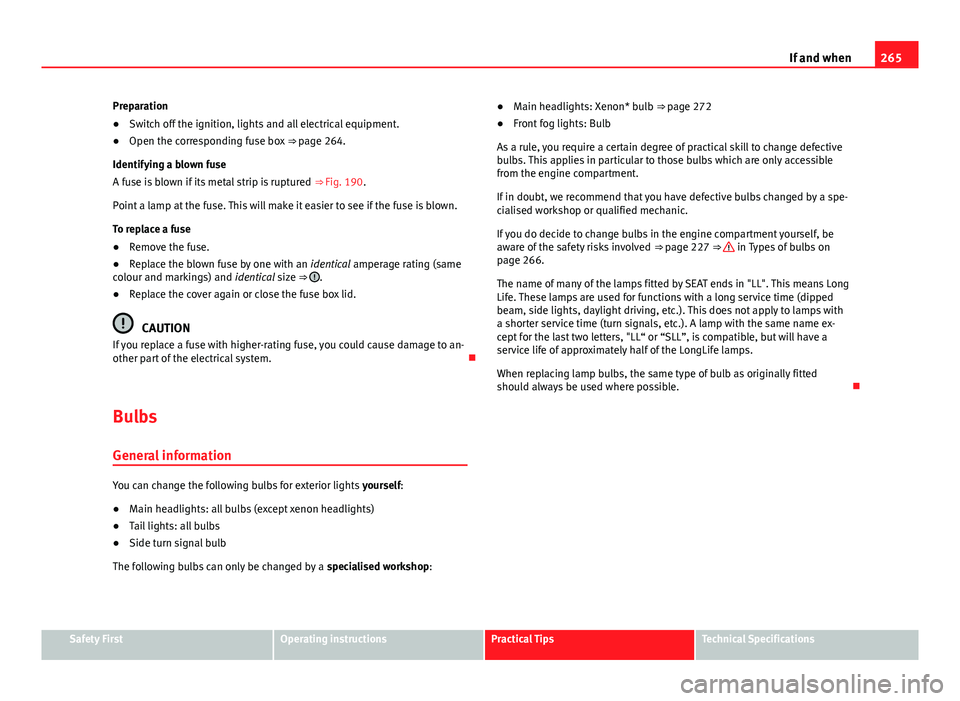
265
If and when
Preparation
● Switch off the ignition, lights and all electrical equipment.
● Open the corresponding fuse box ⇒ page 264.
Identifying a blown fuse
A fuse is blown if its metal strip is ruptured ⇒ Fig. 190.
Point a lamp at the fuse. This will make it easier to see if the fuse is blown.
To replace a fuse
● Remove the fuse.
● Replace the blown fuse by one with an identical amperage rating (same
colour and markings) and identical size ⇒
.
● Replace the cover again or close the fuse box lid.
CAUTION
If you replace a fuse with higher-rating fuse, you could cause damage to an-
other part of the electrical system.
Bulbs
General information
You can change the following bulbs for exterior lights yourself:
● Main headlights: all bulbs (except xenon headlights)
● Tail lights: all bulbs
● Side turn signal bulb
The following bulbs can only be changed by a specialised workshop:●
Main headlights: Xenon* bulb ⇒ page 272
● Front fog lights: Bulb
As a rule, you require a certain degree of practical skill to change defective
bulbs. This applies in particular to those bulbs which are only accessible
from the engine compartment.
If in doubt, we recommend that you have defective bulbs changed by a spe-
cialised workshop or qualified mechanic.
If you do decide to change bulbs in the engine compartment yourself, be
aware of the safety risks involved ⇒ page 227 ⇒
in Types of bulbs on
page 266.
The name of many of the lamps fitted by SEAT ends in "LL". This means Long
Life. These lamps are used for functions with a long service time (dipped
beam, side lights, daylight driving, etc.). This does not apply to lamps with
a shorter service time (turn signals, etc.). A lamp with the same name ex-
cept for the last two letters, "LL“ or “SLL”, is compatible, but will have a
service life of approximately half of the LongLife lamps.
When replacing lamp bulbs, the same type of bulb as originally fitted
should always be used where possible.
Safety FirstOperating instructionsPractical TipsTechnical Specifications
Page 269 of 319
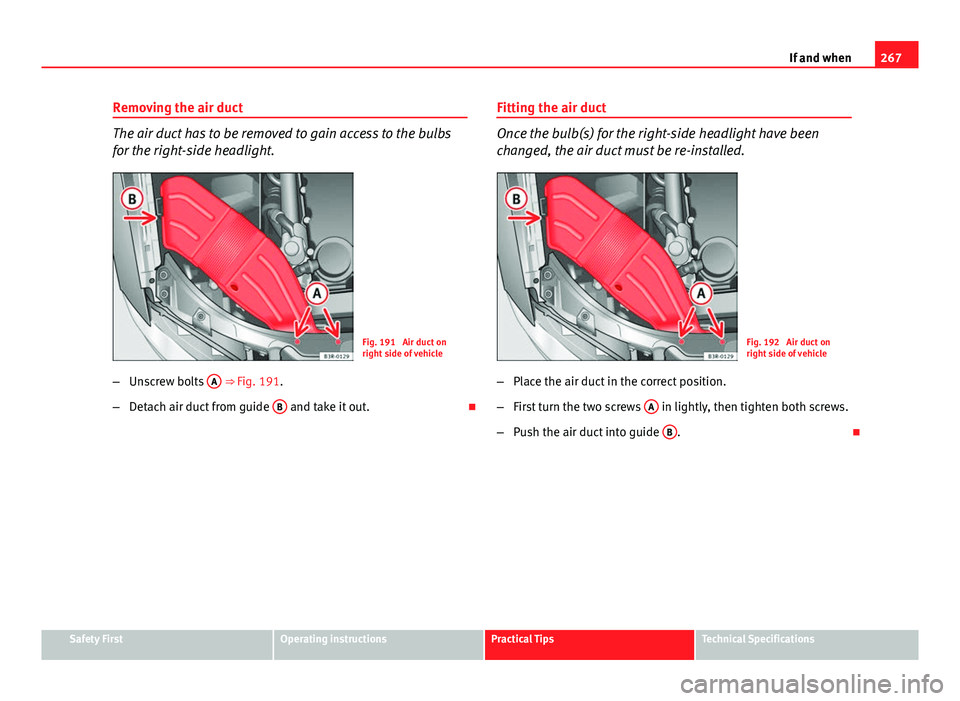
267
If and when
Removing the air duct
The air duct has to be removed to gain access to the bulbs
for the right-side headlight.
Fig. 191 Air duct on
right side of vehicle
– Unscrew bolts A
⇒ Fig. 191.
– Detach air duct from guide B
and take it out. Fitting the air duct
Once the bulb(s) for the right-side headlight have been
changed, the air duct must be re-installed.
Fig. 192 Air duct on
right side of vehicle
– Place the air duct in the correct position.
– First turn the two screws A
in lightly, then tighten both screws.
– Push the air duct into guide B
.
Safety FirstOperating instructionsPractical TipsTechnical Specifications
Page 271 of 319
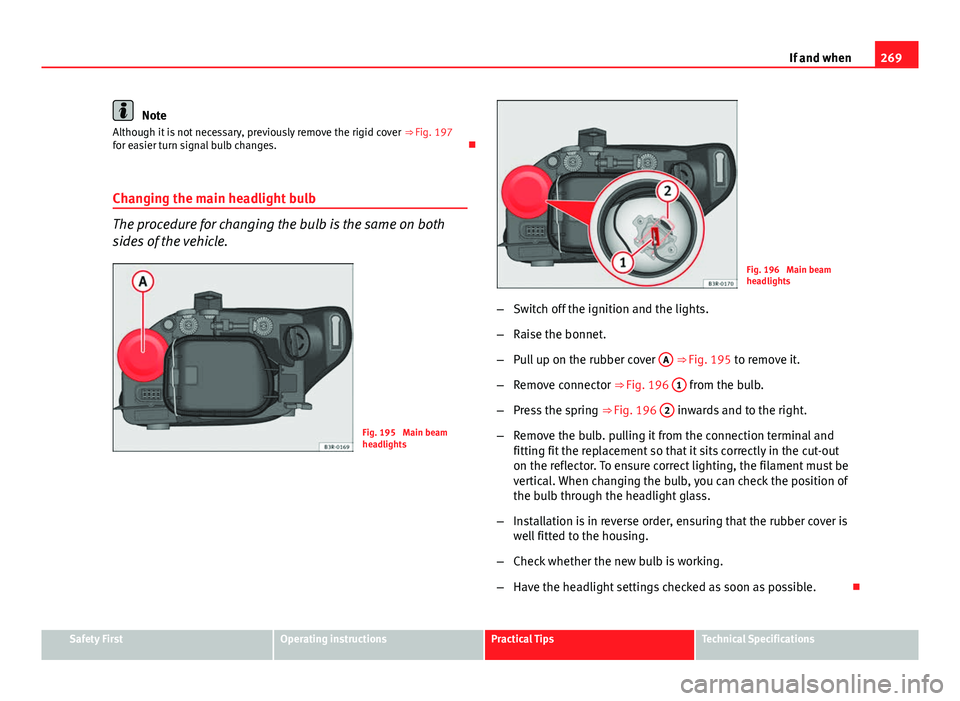
269
If and when
Note
Although it is not necessary, previously remove the rigid cover ⇒ Fig. 197
for easier turn signal bulb changes.
Changing the main headlight bulb
The procedure for changing the bulb is the same on both
sides of the vehicle.
Fig. 195 Main beam
headlights
Fig. 196 Main beam
headlights
– Switch off the ignition and the lights.
– Raise the bonnet.
– Pull up on the rubber cover A
⇒ Fig. 195 to remove it.
– Remove connector ⇒ Fig. 196 1
from the bulb.
– Press the spring ⇒ Fig. 196 2
inwards and to the right.
– Remove the bulb. pulling it from the connection terminal and
fitting fit the replacement so that it sits correctly in the cut-out
on the reflector. To ensure correct lighting, the filament must be
vertical. When changing the bulb, you can check the position of
the bulb through the headlight glass.
– Installation is in reverse order, ensuring that the rubber cover is
well fitted to the housing.
– Check whether the new bulb is working.
– Have the headlight settings checked as soon as possible.
Safety FirstOperating instructionsPractical TipsTechnical Specifications
Page 273 of 319
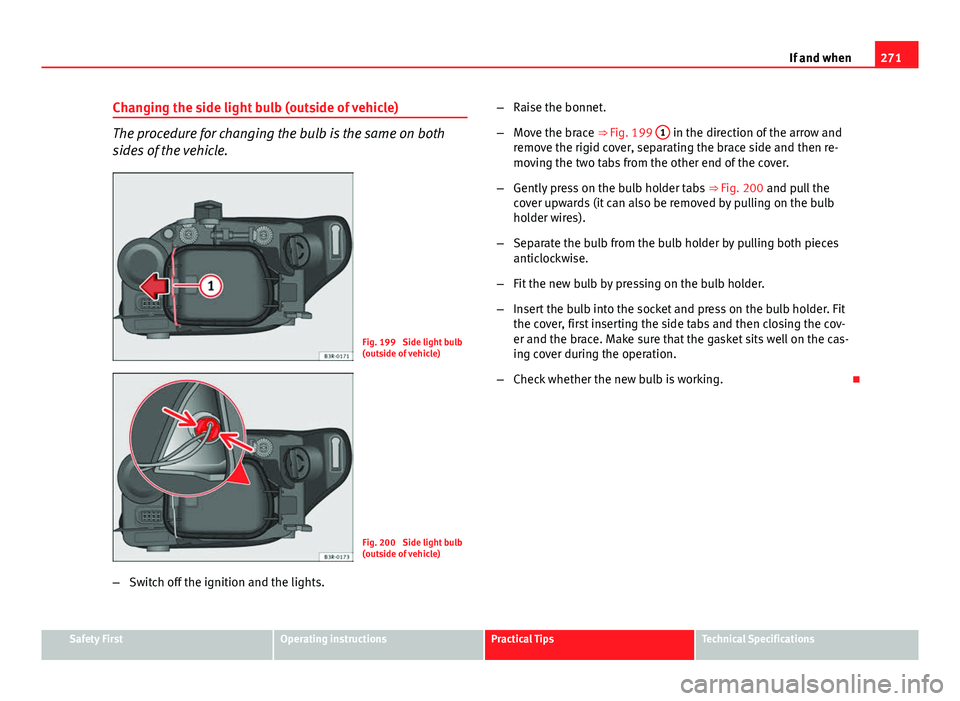
271
If and when
Changing the side light bulb (outside of vehicle)
The procedure for changing the bulb is the same on both
sides of the vehicle.
Fig. 199 Side light bulb
(outside of vehicle)
Fig. 200 Side light bulb
(outside of vehicle)
– Switch off the ignition and the lights. –
Raise the bonnet.
– Move the brace ⇒ Fig. 199 1
in the direction of the arrow and
remove the rigid cover, separating the brace side and then re-
moving the two tabs from the other end of the cover.
– Gently press on the bulb holder tabs ⇒ Fig. 200 and pull the
cover upwards (it can also be removed by pulling on the bulb
holder wires).
– Separate the bulb from the bulb holder by pulling both pieces
anticlockwise.
– Fit the new bulb by pressing on the bulb holder.
– Insert the bulb into the socket and press on the bulb holder. Fit
the cover, first inserting the side tabs and then closing the cov-
er and the brace. Make sure that the gasket sits well on the cas-
ing cover during the operation.
– Check whether the new bulb is working.
Safety FirstOperating instructionsPractical TipsTechnical Specifications
Page 275 of 319
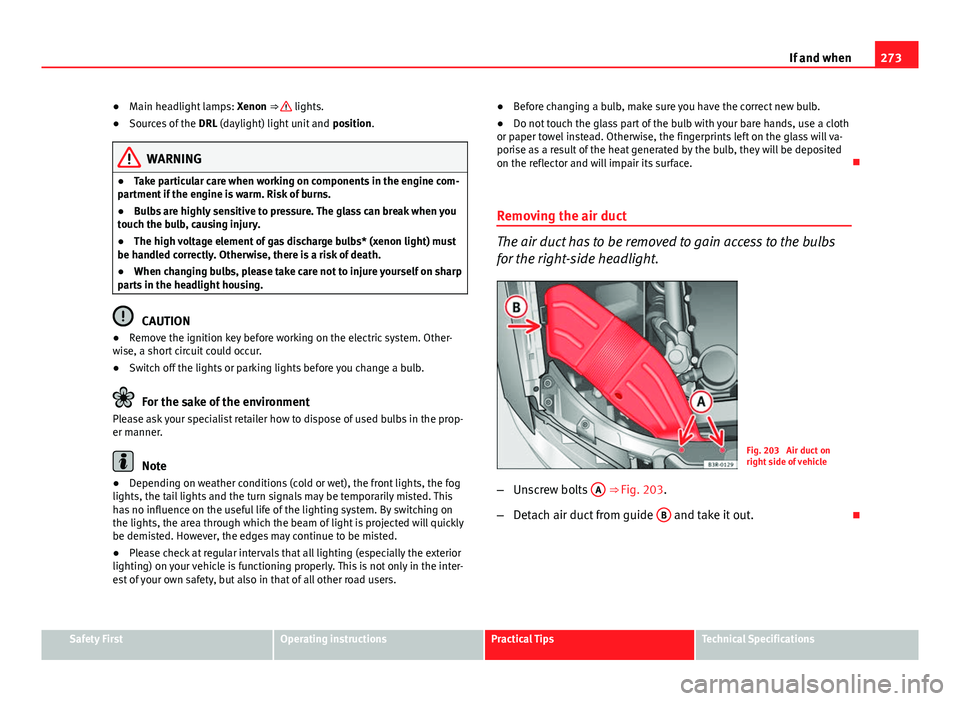
273
If and when
● Main headlight lamps: Xenon ⇒
lights.
● Sources of the DRL (daylight) light unit and position.
WARNING
● Take particular care when working on components in the engine com-
partment if the engine is warm. Risk of burns.
● Bulbs are highly sensitive to pressure. The glass can break when you
touch the bulb, causing injury.
● The high voltage element of gas discharge bulbs* (xenon light) must
be handled correctly. Otherwise, there is a risk of death.
● When changing bulbs, please take care not to injure yourself on sharp
parts in the headlight housing.
CAUTION
● Remove the ignition key before working on the electric system. Other-
wise, a short circuit could occur.
● Switch off the lights or parking lights before you change a bulb.
For the sake of the environment
Please ask your specialist retailer how to dispose of used bulbs in the prop-
er manner.
Note
● Depending on weather conditions (cold or wet), the front lights, the fog
lights, the tail lights and the turn signals may be temporarily misted. This
has no influence on the useful life of the lighting system. By switching on
the lights, the area through which the beam of light is projected will quickly
be demisted. However, the edges may continue to be misted.
● Please check at regular intervals that all lighting (especially the exterior
lighting) on your vehicle is functioning properly. This is not only in the inter-
est of your own safety, but also in that of all other road users. ●
Before changing a bulb, make sure you have the correct new bulb.
● Do not touch the glass part of the bulb with your bare hands, use a cloth
or paper towel instead. Otherwise, the fingerprints left on the glass will va-
porise as a result of the heat generated by the bulb, they will be deposited
on the reflector and will impair its surface.
Removing the air duct
The air duct has to be removed to gain access to the bulbs
for the right-side headlight.
Fig. 203 Air duct on
right side of vehicle
– Unscrew bolts A
⇒ Fig. 203.
– Detach air duct from guide B
and take it out.
Safety FirstOperating instructionsPractical TipsTechnical Specifications
Page 277 of 319
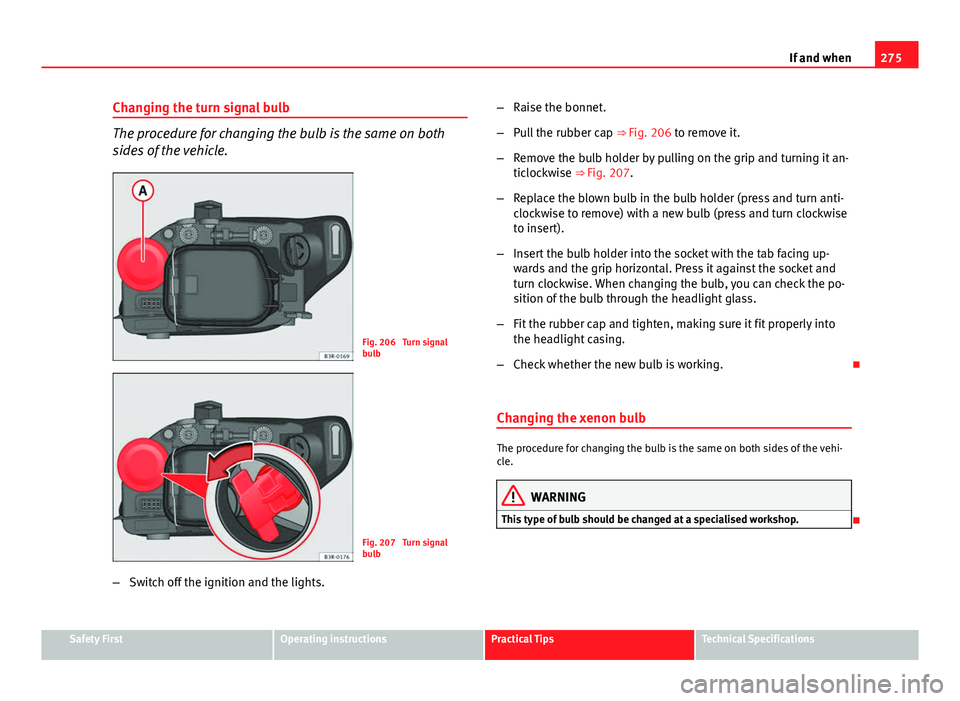
275
If and when
Changing the turn signal bulb
The procedure for changing the bulb is the same on both
sides of the vehicle.
Fig. 206 Turn signal
bulb
Fig. 207 Turn signal
bulb
– Switch off the ignition and the lights. –
Raise the bonnet.
– Pull the rubber cap ⇒ Fig. 206 to remove it.
– Remove the bulb holder by pulling on the grip and turning it an-
ticlockwise ⇒ Fig. 207.
– Replace the blown bulb in the bulb holder (press and turn anti-
clockwise to remove) with a new bulb (press and turn clockwise
to insert).
– Insert the bulb holder into the socket with the tab facing up-
wards and the grip horizontal. Press it against the socket and
turn clockwise. When changing the bulb, you can check the po-
sition of the bulb through the headlight glass.
– Fit the rubber cap and tighten, making sure it fit properly into
the headlight casing.
– Check whether the new bulb is working.
Changing the xenon bulb
The procedure for changing the bulb is the same on both sides of the vehi-
cle.
WARNING
This type of bulb should be changed at a specialised workshop.
Safety FirstOperating instructionsPractical TipsTechnical Specifications
Page 279 of 319
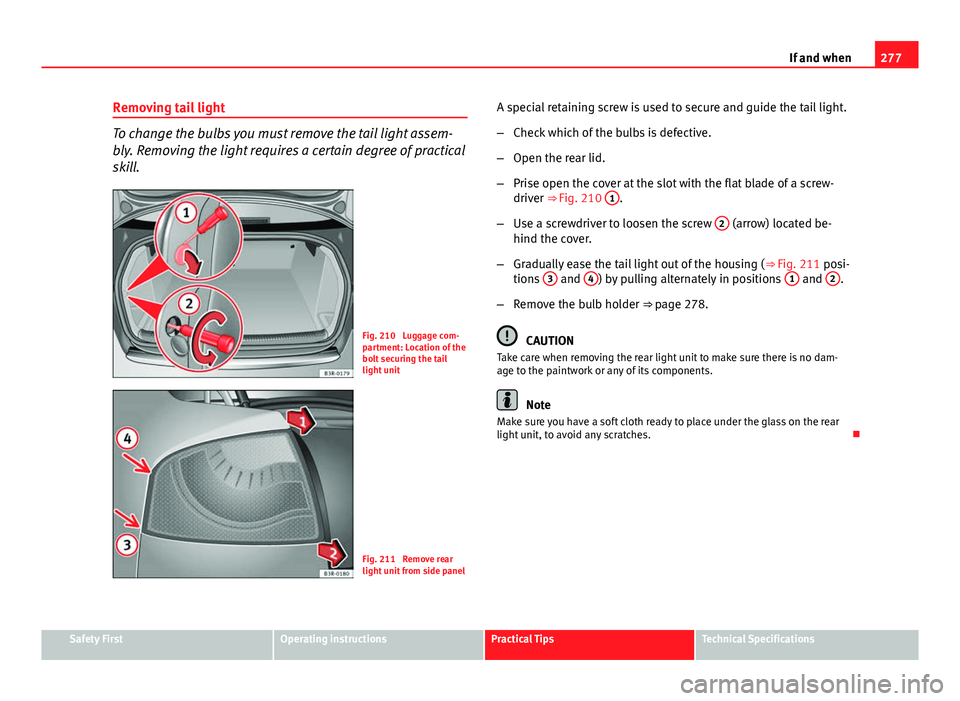
277
If and when
Removing tail light
To change the bulbs you must remove the tail light assem-
bly. Removing the light requires a certain degree of practical
skill.
Fig. 210 Luggage com-
partment: Location of the
bolt securing the tail
light unit
Fig. 211 Remove rear
light unit from side panel A special retaining screw is used to secure and guide the tail light.
–
Check which of the bulbs is defective.
– Open the rear lid.
– Prise open the cover at the slot with the flat blade of a screw-
driver ⇒ Fig. 210 1
.
– Use a screwdriver to loosen the screw 2
(arrow) located be-
hind the cover.
– Gradually ease the tail light out of the housing ( ⇒ Fig. 211 posi-
tions 3
and 4) by pulling alternately in positions 1 and 2.
– Remove the bulb holder ⇒ page 278.
CAUTION
Take care when removing the rear light unit to make sure there is no dam-
age to the paintwork or any of its components.
Note
Make sure you have a soft cloth ready to place under the glass on the rear
light unit, to avoid any scratches.
Safety FirstOperating instructionsPractical TipsTechnical Specifications